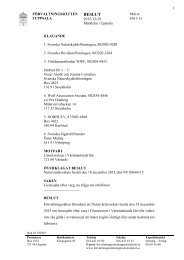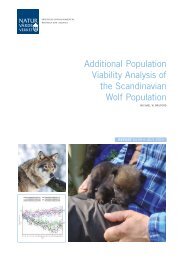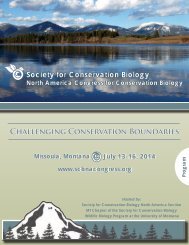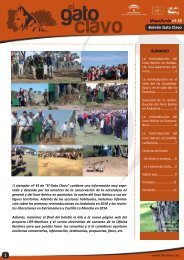1oC3Dbk
1oC3Dbk
1oC3Dbk
You also want an ePaper? Increase the reach of your titles
YUMPU automatically turns print PDFs into web optimized ePapers that Google loves.
16 members. The size of the group is deliberately kept small<br />
at this stage, as the Chair indicated that in the first years of<br />
incumbency the focus should be on two Critically Endangered<br />
and one Endangered species in tropical/subtropical Asia;<br />
namely Great Indian Bustard (Ardeotis nigriceps), Bengal<br />
Florican (Houbaropsis bengalensis) and Lesser Florican<br />
(Sypheotides indicus), although this region also hosts the<br />
severely threatened Asian Houbara (Chlamydotis macqueenii).<br />
Members selected to date all have experience relevant to these<br />
species. Expansion of the group is anticipated in due course.<br />
There are many threats to Asian bustards, including rapid<br />
conversion of grassland and traditional farmland to intensive<br />
agricultural production, although in some places also agricultural<br />
abandonment (landscapes reverting to scrub); overgrazing and<br />
increasing habitat fragmentation and disturbance; declines<br />
in habitat suitability through the proliferation of fences, windturbines<br />
and roads; widespread expansion of suspended<br />
cabling across landscapes (see photograph below); subsistence<br />
off-take of adults, juveniles and eggs; sport-hunting and<br />
mismanagement of protected areas.<br />
Throughout the year, informal advice was provided to<br />
the Indian government and Indian conservation biologists<br />
on bustard-related issues, particularly in the lead-in to a<br />
major government meeting to be held in Delhi, where it will<br />
be decided whether to proceed with captive breeding for the<br />
Great Indian Bustard. Research was conducted by members<br />
of the group on the practicalities of this move and a model<br />
created for K-selected species, which may prove useful to<br />
other groups, seeking to assess the probable outcomes of exsitu<br />
intervention. We supported WCS Cambodia and BirdLife<br />
Cambodia in the conservation of the Tonle Sap floodplain<br />
for the dwindling population of Bengal Florican (subspecies<br />
blandini). This included a review of the new action plan for<br />
the species and providing evidence on land use change and<br />
population decline. Some members of the group also form<br />
part of an initiative to assess the status, ecological needs and<br />
migration patterns of a population of Asian Houbara, breeding<br />
in the Kyzylkum Desert, Uzbekistan, some individuals of which<br />
winter in Pakistan. The Chair gave the Second Ravi Sankaran<br />
Memorial Lecture at the Bangalore Student Conference<br />
on Conservation Science on 25 September 2013, with the<br />
subject ‘Inglorious Bustards’ (a review of bustard biology and<br />
conservation).<br />
Professor Nigel Collar<br />
Chair, Bustard Specialist Group<br />
Butterfly Specialist Group<br />
Our aim is to foster the conservation of butterflies and moths<br />
and their habitats around the world. Our Specialist Group<br />
comprises a membership of 150 and a thirteen member<br />
steering committee from seven geographic regions.<br />
The Butterfly Specialist Group (BSG) was formed in late<br />
2010; the group developed a survey of butterfly conservation<br />
needs, and currently over 161 people from 39 countries have<br />
completed the survey (the full survey is accessible here). We<br />
then developed a listserv from these participants and there has<br />
been good dialogue on a number of butterfly conservation<br />
issues and sharing of research ideas and studies. Several<br />
countries are working on assessments of their butterfly fauna.<br />
The BSG Chair has also focused attention on monarch<br />
butterflies and has been engaged at the highest levels with the<br />
government in Mexico and the United States to improve policies<br />
for habitat conservation. The BSG was also a co-sponsor in the<br />
recent workshop on imperiled checkerspot butterflies on the<br />
west coast of the US. This workshop included scientists, agency<br />
staff from the US and Canada and NGO staff.<br />
The Xerces Society has funded four students since the<br />
inception of the BSG through our DeWind Award. Two of these<br />
awards went to students of Butterfly SG members. ‘Land Use<br />
Abandonment in Eastern Mediterranean – effects on butterfly<br />
and moth communities’ and ‘Consequences of selectiveherbicide<br />
use on butterfly populations: evaluating the<br />
magnitude and persistence of negative herbicidal effects on<br />
the demography of a lycaenid’ (Glaucopsyche lygdamus –<br />
Columbia).<br />
The progress of the Butterfly SG has been slower than we<br />
would like for a variety of reasons; we have yet to develop a<br />
coordinated plan for the SG, communications have been<br />
difficult as it is across all time zones and all of the participants<br />
are busy with their own work. Funding is also a limiting factor in<br />
what we can accomplish. We have convened a meeting<br />
associated with the Butterfly Conservation Symposium in the<br />
UK in April 2014. Most of the steering committee members will<br />
be in attendance. The goals of this meeting will be to develop a<br />
draft needs and opportunity based plan that will allow us to<br />
direct resources and technical assistance to areas with the<br />
greatest need and highest potential for our efforts to make a<br />
meaningful impact; identify an RLA for the group, and discuss<br />
how we might fund activities – including coordination.<br />
Scott Hoffman Black<br />
Chair, Butterfly Specialist Group<br />
Asian Houbara. © Andy Swash (WorldWildlifeImages.com) / EBBCC<br />
Taylors Checkerspot. © Dana Ross<br />
38 IUCN species Annual Report 2013






